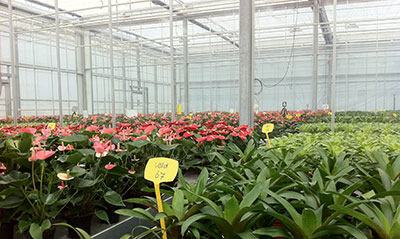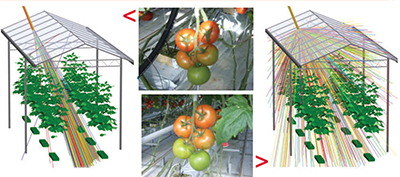
Features
Lighting
Structures & Equipment
Benefits of diffuse light
May 14, 2014 By Kerstin P. Ouellet
Bringing more light into the greenhouse has long been a goal of growers
everywhere, and Dutch researchers have now set out on a multi-year study
to determine the benefits of harnessing more diffuse light in
particular.
Bringing more light into the greenhouse has long been a goal of growers everywhere, and Dutch researchers have now set out on a multi-year study to determine the benefits of harnessing more diffuse light in particular.
 |
|
| Wageningen UR is conducting trials with plants grown under light-diffusing screens. PHOTOS COURTESY WUR Advertisement
|
In recent trials at the Netherlands’ Wageningen UR Greenhouse Horticulture, researchers found that producing potted plants under a light-diffusing screen (curtain) shortens the production time by 25 per cent, and results in better quality plants.
They say being able to utilize diffuse light only when needed appears to be key to these increases, and in this case they employed a retractable screen to compare the effects of removable, deployable diffuse light versus stationary diffuse light screens and coatings.
The findings surprised even the scientists, with impacts not only to the growing cycle but also quality and weight.
MORE LIGHT FOR MORE PHOTOSYNTHESIS
Diffuse light is much softer and less harsh than the typical direct light found in most greenhouses. Scattered by particles, diffuse light seems to come from all directions. Think of light that comes through a cloud, rather than directly from the sun.
Today’s advanced greenhouse coverings and screens can diffuse the light so it is much more evenly distributed, producing fewer hot spots and shady spots. Diffuse light also offers the added ability to penetrate deeper into even the thickest plant canopies, activating more photosynthesis and enhancing the plants’ growth.
Harnessing these growth enhancements with retractable diffuse light screens is the focus of the WUR researchers’ multi-part, $1.7 million study.
DIFFUSING LIGHT WHEN YOU NEED IT
In the first study, researchers compared light-diffusing screens to standard greenhouse screens. They chose the Svensson Harmony Revolux XLS 55 F for this project, and also equipped every greenhouse with standard glass as well as energy screens from Svensson. Automated misting systems kept relative humidity levels high.
The control greenhouse saw maximum light per day of 5 mol PAR/m2 cumulative. The shade on the control greenhouse provided unscattered, direct light. Two additional 150 m2 greenhouse zones were equipped with the retractable light-diffusing Harmony screens, which allowed light levels 50 per cent and 100 per cent above those the typical greenhouse grower uses, 7.5 mol PAR/m2 and 10 mol PAR/m2.
Each zone produced the same mix of pot plants: sections of Royal Champion and Pink Champion Anthuriums and of Guzmania Rana and Vriesea Miranda Bromeliads. (Phalaenopsis orchids are the subject of the second phase of the study, in process at the WUR now.)
Scientists measured photosynthesis in plants with their own advanced plant activity meter plant monitoring system, developed at the WUR. This allowed them to monitor plant stress and also predict whether plant damage was forthcoming.
Anthurium pot plants produced in light-diffused greenhouses equipped with Svensson’s Harmony screens were ready for sale six weeks earlier than the normal production cycle, says Leo Marcelis, lead researcher of the WUR. Plants were also notably better quality. The Bromeliad varieties were also ready ahead of schedule.
While Anthuriums are typically ready for sale at 22 weeks, the pot plants in the diffused-light greenhouses were ready at 16 weeks. In addition, quality was significantly improved, with plants in the 10 mol greenhouse 25 per cent heavier than is typical.
For the Bromeliads, researchers performed the flowering treatment two to four weeks earlier than is typical, and reported that production of the varieties of Guzmania and Vriesea was also sped up. Plants were ready up to four weeks earlier than normal and were also significantly heavier than expected, signifying better quality and bulk.
The faster growth rate also led to an interesting observation: the Vriesea produced more side shoots. Researchers theorize this would be offset by tweaking plant intensity and temperature.
NO PLANT DAMAGE
While leaf burn and plant damage are typically concerns when working with higher levels of direct light, as researchers expected, these high diffuse light levels produced no such effects. There were no reports of leaf damage; rather all plants were higher than average quality.
“The results are clear: allowing more light and while applying the light-diffusing Harmony shading screen, together with an adapted climate strategy, results in 25 per cent growth speedup and a higher quality of pot plants,” says Paul Arkesteijn, climate performance analyst with AB Ludvig Svensson.
The bottom line, researchers say, is using diffuse light on demand, when you need it. You’ll bring more natural light into your greenhouse and positively impact your pocketbook, growth rate and quality alike.
WHAT IS DIFFUSE LIGHT
This is light that’s scattered rather than direct.
 |
|
| GRAPHIC COURTESY WUR
|
Consider this example, where a light-diffusing screen scatters light in a greenhouse, allowing it to better penetrate the canopy and stimulate growth (right).
This is in contrast to direct light, which stays primarily at the top leaves, providing much less photosynthetic activity and thus less productivity.
Kerstin P. Ouellet is owner of Pen & Petal, Inc., a marketing, advertising and public relations agency for the green industry.
Print this page